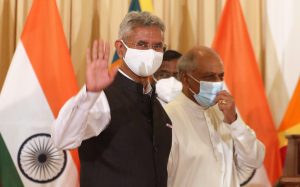Thilina Panduwawala

Indian Foreign Minister S. Jaishankar waves to the media as he leaves with his Sri Lankan counterpart Dinesh Gunawardena after addressing a joint media briefing in Colombo, Sri Lanka, Jan. 6, 2021.Credit: AP Photo/Eranga Jayawardena
In 2022, as Sri Lanka’s economy entered into its biggest crisis since independence, the emergency financing extended or facilitated by India amounted to about $4 billion. Sri Lanka used about $3.3 billion during the course of the year, especially in the tumultuous first seven months. India became Sri Lanka’s lender of last resort even as the island entered sovereign default.
A lender of last resort is the place a person, firm, financial institution, or country to which a country turns when in urgent need of funds. As the term suggests, a lender of last resort is the only chance once all other options have been exhausted. While the International Monetary Fund (IMF) is the global institution that is meant to be the lender of last resort for sovereign states, the delays in governments’ approaching the IMF and the length of the IMF’s processes can often mean that other countries or institutions need to step into provide emergency financing before IMF funding kicks in. For instance, the United States acted as a lender of last resort during Mexico’s 1994 crisis.
Sri Lankans headed into 2022 hoping for some support from both India and China in the face of mounting economic and financial woes. However, the magnitude of Indian financing – and the lack of anything in comparison from China – came as a significant surprise. In fact, Indian External Affairs Minister S. Jaishankar’s recent comments highlight that India perceives the significant emergency financial assistance it rendered to Sri Lanka in 2022 as a pivotal point in the expansion of its role within South Asia and the wider Indian Ocean region:
The linkage and perception today of India in the neighborhood has changed, and nothing illustrated that more dramatically than what happened to Sri Lanka last year when it went through a very deep economic crisis… And we have actually stepped forward in a way in which we ourselves never have before. What we have done for Sri Lanka is bigger than what the IMF has done for Sri Lanka.
How Did India Became a Lender of Last Resort?
Heading into 2022, the Central Bank of Sri Lanka had only about $1.6 billion in forex reserves, sufficient for less than one month of imports at the time. While Sri Lanka also had a 10 billion yuan currency swap from China’s central bank, the People’s Bank of China, it was not usable since total reserves were below the required level (enough to cover three months of imports).
Meanwhile, Sri Lanka faced about $6.9 billion in foreign currency debt repayments scheduled to be made over the course of 2022, in addition to financing the country’s usual current account deficit. Of the $6.9 billion, about $1.2 billion was due in January 2022, including a $500 million International Sovereign Bond (ISB) maturing on January 18. With no access to international capital markets to raise new commercial foreign debt and multilaterals also unwilling to extend new financing amid concerns about Sri Lanka’s debt sustainability, the central bank was facing a significant drain on remaining usable forex reserves.
No comments:
Post a Comment